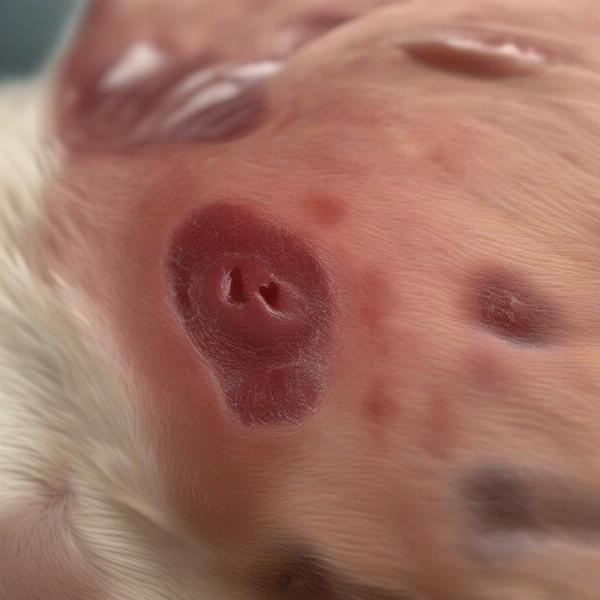Wells syndrome, also known as eosinophilic cellulitis, is a relatively uncommon skin condition that affects dogs. Characterized by painful, swollen, and often itchy lesions, Wells syndrome can be a concerning experience for both dog and owner. This article delves into the causes, symptoms, diagnosis, and treatment options for Wells syndrome in dogs, equipping you with the knowledge to navigate this complex skin issue.
Understanding the underlying cause of Wells syndrome is crucial for effective management. While the exact etiology remains unknown, it’s believed to be an immune-mediated inflammatory reaction. This means the dog’s immune system mistakenly attacks its own skin tissue, leading to the characteristic lesions. Several factors can trigger this reaction, including insect bites, parasitic infections, underlying allergies (environmental or food), and even certain medications.
Recognizing the Symptoms of Wells Syndrome in Dogs
Wells syndrome often presents suddenly, with distinct raised, red, and often circular or target-shaped lesions. These lesions can be warm to the touch and may be accompanied by intense itching. They typically appear on the trunk, legs, and face, but can develop anywhere on the body. In some cases, dogs may also experience fever, lethargy, and loss of appetite.
 Dog with Wells Syndrome Lesions
Dog with Wells Syndrome Lesions
Diagnosing Wells Syndrome: Veterinary Expertise is Key
Diagnosing Wells syndrome requires a thorough veterinary examination. Your veterinarian will likely take a detailed history, including any recent changes in your dog’s environment, diet, or medications. A skin biopsy is typically necessary to confirm the diagnosis. This involves taking a small sample of the affected skin tissue and examining it under a microscope to look for the characteristic infiltration of eosinophils, a type of white blood cell associated with inflammation.
Treatment Options and Management Strategies
Treatment for Wells syndrome focuses on managing the inflammation and alleviating the dog’s discomfort. Corticosteroids, such as prednisone, are often prescribed to reduce inflammation and suppress the immune response. In some cases, other immunosuppressive medications may be necessary. Antihistamines can help to control itching, while antibiotics may be used if a secondary bacterial infection is present.
Long-Term Management and Prognosis
The prognosis for dogs with Wells syndrome is generally good, with most cases resolving within a few weeks to months with appropriate treatment. However, recurrences are possible, and some dogs may require long-term management with medication or other therapies. Regular follow-up with your veterinarian is essential to monitor the dog’s progress and adjust treatment as needed.
Preventing Future Episodes: A Proactive Approach
While not always preventable, identifying and addressing any underlying triggers, such as allergies or parasites, can help reduce the risk of recurrence. Regular parasite prevention is crucial, as is managing any environmental or food allergies that your dog may have.
Frequently Asked Questions about Wells Syndrome in Dogs
- Is Wells syndrome contagious? No, Wells syndrome is not contagious to other animals or humans. It is an immune-mediated condition specific to the affected dog.
- Can Wells syndrome be cured? While most cases resolve with treatment, recurrences are possible. Long-term management may be necessary for some dogs.
- What should I do if I suspect my dog has Wells syndrome? Contact your veterinarian immediately for a proper diagnosis and treatment plan.
- Are certain breeds predisposed to Wells syndrome? While any breed can be affected, some breeds like Boxers, German Shepherds, and Siberian Huskies may be more susceptible.
- Can diet play a role in Wells syndrome? Food allergies can be a trigger for Wells syndrome. Your veterinarian may recommend a food trial to identify any dietary sensitivities.
- How long does it take for Wells syndrome lesions to heal? Healing time varies, but with appropriate treatment, most lesions resolve within a few weeks to months.
- What are the potential complications of Wells syndrome? Secondary bacterial infections can occur if the lesions are not treated promptly.
ILM Dog is your trusted partner in canine care. We offer expert advice on all aspects of dog ownership, from breed selection and health care to training and nutrition. Whether you’re a new dog owner or a seasoned pro, our resources can help you provide the best possible care for your furry friend. Our services include breed selection guidance, health & wellness advice, training & behavioral consultations, nutrition planning, and product recommendations. For personalized support, contact us at [email protected] or call us at +44 20-3965-8624. ILM Dog is dedicated to helping you navigate the joys and challenges of dog parenthood.